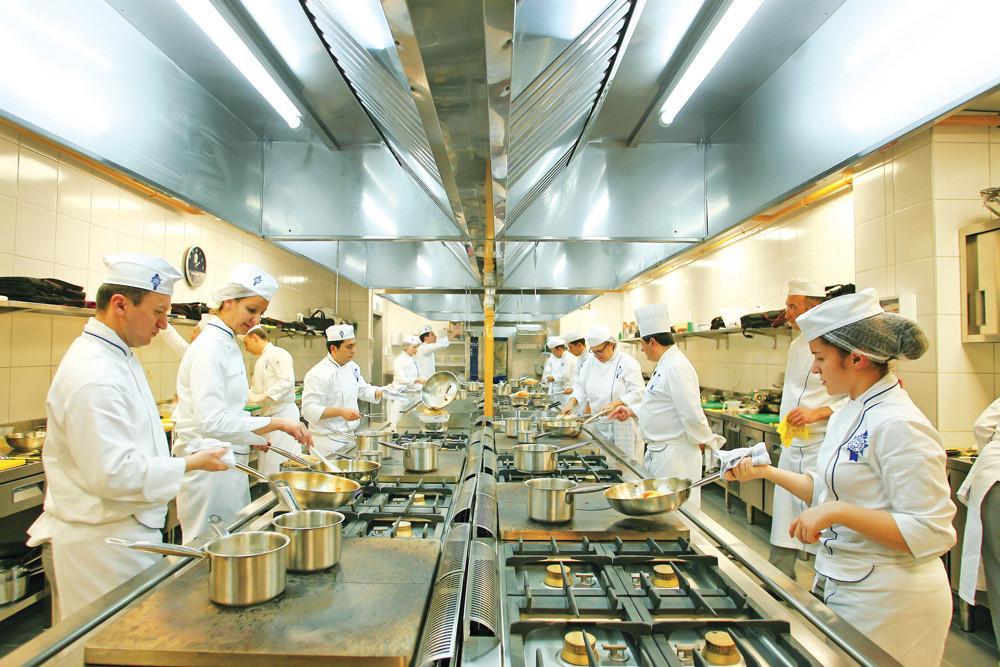Preparing future chefs in Turkey to tap into gastro tourism
DİLARA DİNER

The pieces of lomo (beef tenderloin) go on top of the rice but the rice, which had been plated in a nice shape, had already started collapsing before I could even touch it with the tip of my fork. While I am not an expert on Peruvian cuisine, tastewise, the meat was as soft as a cloud and the marinade was divine. The rice was slightly too greasy, but the mixture with cilantro gave it just the right finesse. You could tell the design the chef had aimed for—this was not any kind of plate—it was a plate in process.
Özyeğin University’s L’Atelier Bleu has opened its doors for visitors to try out new tastes during the international cuisine courses attended by gastronomy students, as well as students from the hotel management department.
The greatest part of the experience was the wide glass window separating the restaurant from the kitchen, where you could eat while watching students cook with the instruction of their teacher, Chef Erich Ruppen.
“They learn about culture too,” said Ruppen. “For example, you can find many ingredients belonging to Asian cuisine in the Peruvian cuisine, such as soy sauce, due to the wide immigration of Asians to Peru,” he said.
“Or this plate, like most poor people’s food, has many ingredients, such as potatoes, corn, beans, pumpkin, and poached egg,” said the chef.
The poached egg was slightly overcooked though. “Well, sometimes you need a little luck too!” he said, laughing.
The students have three hours until they get everything ready for groups who come for lunch.
“We make everything from scratch, even the bread and the grissini. So, it can be stressful at times,” explained the chef.
“In a restaurant, you can be much stricter and dictate what has to be done, but here, you have to recognize they are students and they are going to make mistakes,” said the Swiss-born chef, who joined the Cordon Bleu Istanbul team in 2017.
Özyeğin University and Le Cordon Bleu have been in partnership since 2012, where Turkey’s future chefs receive training from Le Cordon Bleu International Master Chefs.
Ruppen, who came to Turkey in 1990, has worked at the Çırağan Palace for over five years. He is very familiar with Turkish cuisine. “Kuru fasulye with pastırma! It’s my comfort food in Turkey,” he said.
There is a significant difference in the sector compared to his early days in Turkey.
“Most five star hotels had foreign chefs, but would have to train their employees, as they generally had no prior education. They would come from places like Bolu and start directly in the kitchen, lacking technique and basic knowledge of their way around a kitchen,” said Ruppen. “The standing of chefs has also evolved immensely. Years ago, chefs were hidden in the kitchen. Nowadays, they are public figures, they are on TV,” said Ruppen, recalling that his Turkish wife’s family had not been impressed upon hearing their daughter was marrying a chef.
“There is an increasing awareness about the importance of gastro tourism. In that sense, we believe we have undertaken a pioneering mission to prepare future generations for a sector that has huge potential,” said Le Cordon Bleu Turkey Director Defne Ertan Tüysüzoğlu.
‘Glocal’ tendency in gastronomy
The new tendency in the world of gastronomy is “glocal.” New generation chefs all around the world highly value local techniques and local ingredients, according to Tüysüzoğlu.
“It is very important for us that our students speak two languages,” she said.
“When I say languages, I refer to culinary languages, not linguistics. First, they all have to know international techniques. Mastering those techniques will put them among their international counterparts. On the other hand, they have to learn local ingredients and traditional techniques and adapt them to modern tastes and presentations with new technologies. That will place them apart from others and help put their name and style in the culinary world,” said the director.
One of our “Grand Diplôme” alumni, Umut Karakuş, represents this approach perfectly with what he does at the Aila Restaurant. Besides using many local ingredients, such as Afyon sucuk, tarhana, tarragon, and freekeh, he also revisits traditional culinary techniques. Karakuş makes kurut, a dried yogurt dish, which takes days to make in the traditional way on rooftops under the sun in Anatolia. Instead, he uses a food dehydrator to achieve the same result. Last month, Chef Umut was back at the school as a guest instructor chef, to teach our students in the ‘Turkish Culinary Heritage’ course given by Assistant Professor Özge Samancı how to make traditional ‘topik’ and his new version with squid ink,” said Tüysüzoğlu.
The program is also open to those who would like to change their careers or to those who are already in the sector but want to develop their technical abilities and receive an internationally accepted certificate or simply deepen their curiosity in gastronomy. While students are required to know English, simultaneous translation is provided for the rest. The new certificate program is due to start on May 7.
















